Many varieties of the flower cards once existed,
and are now extinct. Some of them were patterns related to particular places in
Japan, and bore the name of cities, such as the
Yamagatabana;
among them was the
Dairen, after the Chinese city in
southern Manchuria, born during Japan's occupation of this region.
Also size varieties existed. Some patterns were alternatively made in a smaller version,
called
Kobana ("small flower cards"); for instance,
Echigokobana was the small version of the standard-sized
Echigobana,
and besides the reduced dimensions also the illustrations had a few differences.
Other cards, known as
Usukuchibana ("thin flower cards") were less thick
than the usual Japanese cardstock, and were used by women.
Editions both small and thin, instead, were called
Kaichuubana
("pocket flower cards"), easy to carry and to hide away.
The following table summarizes the names of the recorded patterns. This list
may be incomplete: some of the patterns have an alternative name, and an official classification
scheme has only been attempted in very recent years. However, a true distinction between
the local patterns was only to be found from the Meiji period (1868-1912) onwards, as most
samples prior to this time seem to contain elements in common with more than one pattern.
All of their names have the suffix
-bana, i.e. "-flower",
which specifies their belonging to the group of
Hanafuda, or flower
cards.
REGIONAL PATTERNS
(map reference)

Hachihachibana
(generic pattern)
|

Awabana
a.k.a.

Kintokibana
1 |

Bizenbana
2 |

Dairenbana
3 |

Echigobana
4 |

Hanamakibana
5 |

Higobana
6 |

Hokkaibana
7 |

Nanbubana
8 |

Yamagatabana
a.k.a.

Ôshuubana
9 |
OTHER VARIANTS
BY SIZE AND THICKNESS

Kobana |

Kaichuubana |

Usukuchibana |
|
|
BY NUMBER OF SUITS

Mushibana |
|
All of these patterns have the same composition of the general pack described in
page 2, except the following two:
the Mushibana, whose main feature is to lack two suits, Botan (peony) and
Hagi (bush clover), for a total of 40 cards; the name of this particular pattern
comes from the game of Mushi, i.e. "insect", played with this deck, but the
graphics are the same as generic Hanafuda cards ( Hachi-Hachi pattern);
the Ryuukobana, i.e. "dragon and tiger flower
cards", recently created, for four players (instead of the usual two),
which has two additional suits, and is mentioned in page 4,
among the special decks.
|
 |
Two regional Hanafuda patterns are presented in this page: the
Echigobana and the Kintokibana.
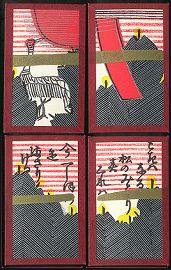
the full suit of Matsu (pine) |
Echigo is the former name of the present Niigata, in
the central-northern part of the country.
The main features of this pattern are an extensive use of
silver and gold details over the main illustrations, and the presence of short poems (tanka)
added to kasu or trash cards belonging to the Matsu (pine), Ume (plum), Fuji (wisteria),
Shôbu (iris), Susugi (silver grass) and Momiji (maple leaves) families. |

the Sakura (cherry)
"curtain" card |
The tanka are divided into two halves, featured on each of the two kasu cards.
This graphic element, which has nothing to do with the gambling game, was probably
conceived as an attempt of disguising Hanafuda cards as Uta Karuta, or
"poet cards" (see the relevant gallery), since the latter
were not prohibited.
|
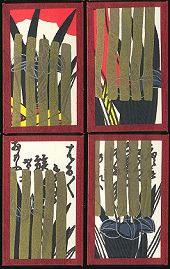
the full suit of
Shôbu (iris) |
With the same purpose are also consistent the heavy silver and
golden additions, some of which do not look as decorations, but probably are an expedient
for almost completely covering the underlying subject (e.g. the suit of Shôbu, or iris),
in a fashion similar to the "distorted" court cards in Mekuri and Kabu
patterns (see page 5 and page 6
for some samples). Not in all editions, though, these coverings are so evident as in the
samples shown. |
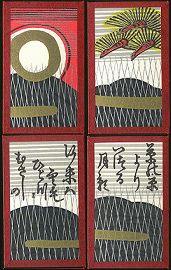
top: full suit of
Susuki (silver grass) |
Some of the animals featured in tane cards are considerably stylized, in particular
the boar in Hagi (bush clover), and the deer in Momiji (maple leaf). The blue ribbons,
i.e. those of Botan or peony, Kiku or chrisanthemum and Momiji, in this pattern have a very
dark colour.
But probably the most peculiar detail of the Echigobana deck is the "rain" card, which features a folded
umbrella with two legs (evidently the calligraphist is inside!), while no trace of the
usual frog is left.
|
below: full suit of Yanagi (willow);
note the peculiar "rain" card
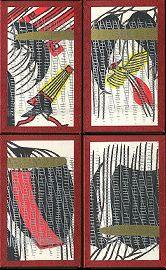
|
However, a folded umbrella was also found in the
Yamagatabana pattern, now extinct,
but also in early editions (19th century, see below). This is not the only element
of similarity with the original
Hanafuda decks; also
tanka poems featured in
some of the
kasu cards, as well as other minor graphic details, reveal that the
Echigobana pattern is modelled on the pre-Meiji flower card decks (i.e. prior to 1868),
while the design of the common
Hachihachibana pattern , as well as some others, was created
during the Meiji age (see
page 2).

blue ribbon of Momiji |
Modern editions comprise an extra card, but it does not specifically
belong to the Echigobana pattern; the one used in Ôishi's edition, shown
on the right, generically features the manufacturer's logo: a Tengu (a traditional character
with a long nose).
A different edition of Echigobana cards is shown in D.King's page
PLAYING CARDS OF THE WORLD.
|

the extra card |
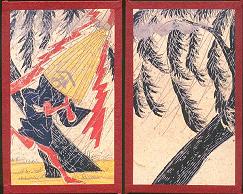
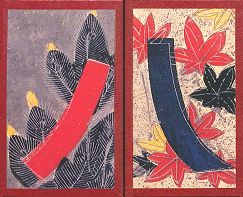
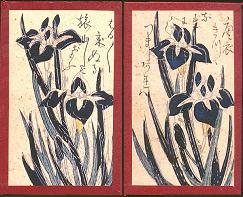
19th century flower card deck (reprint by Ôishi), showing some graphic details retained by
the Echigobana pattern:
the folded umbrella, the white background of the kasu card from the same Willow family, the plumpy shape of trees in Pine,
the very dark colour of the blue ribbons, the tanka poems on kasu cards of six families (Iris, in this sample)
 OR
OR
AWABANA or KINTOKIBANA
all the samples shown come from an edition by Ôishi, Kintengu brand (Japan)
The Kintokibana (officially Awabana) is a pattern
born in Awa (Shikoku island, presently in the prefecture of Tokushima). The name
Kintoki is referred to the legendary personage featured on the extra card (see below).
Later, this pattern spread to the north, towards the mainland, where today is the prefecture
of Okayama.
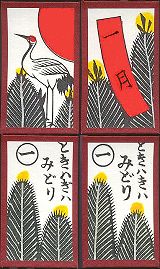
the full suit of Matsu (pine);
note the verses on the kasu cards
|
The most outstanding feature of the pattern is the presence of numerals, referring to
the twelve families or suits. They are found on almost every kasu (trash) card, in the
shape of an encircled Japanese-Chinese character.
Also all the tan (ribbons) but one
feature a number, which is a part of the name of the month in Japanese language: "month 1" is
January i.e. the suit of Matsu (pine), "month 2" is February i.e. the suit of Ume (plum), and
so on.
Only two tane cards, from the suits of Fuji (wisteria) and Yanagi (willow), bear
the encircled number, while the latter is not featured in other subjects, among which are
all five kô cards. |
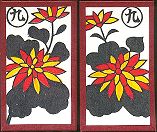
kasu cards from the suit
of Kiku (chrisanthemum) |
|
Only the suit of Kiri (paulownia), shown further down, has all four numberless cards.

tane and tan cards from the suit
of Fuji (wisteria): the ribbon
reads "4th month" (April) |
The use of numbers in this pattern is likely a trace of the time when Kabu
and Mekuri games were prohibited, and Hanafuda packs were often used as legal
substitutes for by-passing the ban. In fact, thanks to the added numbers the twelve Hanafuda
flower families may be easily turned into four series of values from 1 to 12, i.e. as Mekuri
and most Kabu patterns have (see page 5 and
page 6 for details). |
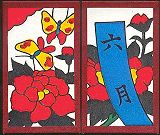
tane and tan cards from the suit
of Botan (peony): the ribbon
reads "6th month" (June) |
Besides the numbers, other differences with the "standard" Hanafuda pattern described in
page 2 are the details in many individual cards: the striped pines in the suit of Matsu, the
decorated curtain in the suit of Sakura, the white/silver blades of grass in the
Susuki cards, the plain white background of the only kasu card of Yanagi (usually red),
and a few others.
Furthermore, the kasu cards of Matsu and Susuki feature a tanka, similar to
the ones found in the aforesaid Echigobana pattern, whose text is incomplete. |
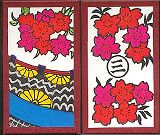
kô and kasu cards from the suit
of Sakura
(cherry blossom) |
 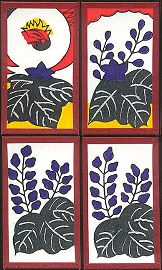
the full Yanagi and Kiri suits
|
Finally, the extra subject of the Kintoki deck,
after which this pattern was renamed: the Kintarô card.
Very popular in the Japanese folk tradition, yet based on
a personage who actually lived around the 10th century, Kintarô was a child
of extraordinary strength, who outrooted trees and wrestled with bears in the mountains
where he lived. |

the Kintarô card |
Once grown up, he became a distinguished warrior or samurai, changing his name
into Kintoki Sakata.
|
He is traditionally featured as a rather stout boy with tanned (red) skin, who
wears only a breastplate with a large character for "gold" (kin), and carries an axe.
other pages in this gallery
OTHER GALLERIES






















or back to

INTRODUCTION
AND HISTORY
|

MULTI-LANGUAGE
GLOSSARY |

THE FOOL &
THE JOKER |

INDEX
TABLE |

REGIONAL
GAMES |

PLAYING CARD
LINKS |